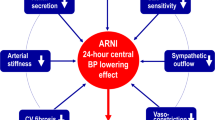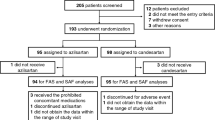Abstract
The objective of this study was to examine the effect of angiotensin II (Ang II) and angiotensin II type 1 (AT1) receptor blockade on pulse wave velocity (PWV) in healthy humans. We studied nine young male volunteers in a double-blind randomised crossover design. Carotid-femoral PWV (an index of arterial stiffness) was measured by using a Complior® machine. Subjects were previously treated for 3 days with once-daily dose of either a placebo or valsartan 80 mg. On the third day, they were infused with either placebo or 5 ng/kg/min of Ang II over 30 min. Subjects thus received placebo capsule + placebo infusion (P), valsartan + placebo infusion (V), placebo + Ang II infusion (A), and valsartan + Ang II infusion (VA) combinations. Heart rate (HR), blood pressure and PWV were recorded at baseline and then every 10 min during infusion and once after the end of infusion. There were significant increases in systolic blood pressure (SBP), diastolic blood pressure (DBP) and mean arterial pressure (MAP) with A compared with P (P = 0.002, P = 0.002, P = 0.001 respectively). These rises in blood pressure were completely blocked by valsartan. A significant rise in PWV by A was seen compared with P (8.38 ± 0.24 vs 7.48 ± 0.24 m/sec, P = 0.013) and was completely blocked by valsartan; VA compared with P (7.27 ± 0.24 vs 7.48 ± 0.24 m/sec, P = NS). Multiple linear regression analysis showed that blockade of Ang II induced increase in blood pressure by valsartan contributed to only 30% of the total reduction in Ang II induced rise in PWV (R2 = 0.306). The conclusions were that valsartan completely blocks the effect of Ang II on PWV. The effect of Ang II on PWV is mediated through AT1receptors. Reduction in PWV by Ang II antagonist is not fully explained by its pressure lowering effect of Ang II and may be partially independent of its effect on blood pressure.
This is a preview of subscription content, access via your institution
Access options
Subscribe to this journal
Receive 12 digital issues and online access to articles
$119.00 per year
only $9.92 per issue
Buy this article
- Purchase on Springer Link
- Instant access to full article PDF
Prices may be subject to local taxes which are calculated during checkout




Similar content being viewed by others
References
Asmar RG et al. Reversion of cardiac hypertrophy and reduced arterial compliance after converting enzyme inhibition in essential hypertension Circulation 1988 78: 941–950
Perret F et al. Evaluation of arterial compliance-Pressure curves: effect of antihypertensive drugs Hypertension 1991 18 (Suppl II): II-77–II-83
Naftilan AJ, Pratt RE, Dzau VJ . Induction of platelet derived growth factor A-Chain and C-myc gene expressions by angiotensins in cultured rat vascular smooth muscle cells J Clin Invest 1989 83: 1419–1424
Bunkenberg B, Van Acmisoort T, Rogg FF, Wood JM . Receptor mediated effects of angiotensin II from spontaneously hypertensive rats Hypertension 1992 20: 746–754
Benetos A et al. Influence of angiotensin converting enzyme and angiotensin II type 1 receptor gene polymorphism on aortic stiffness in normotensive and hypertensivepatients Circulation 1996 94: 698–703
Rehman A, Rahman ARA, Rasool AHG . The effect of angiotensin II on pulse wave velocity in healthy human; a placebo controlled dose response study J Hypertens 2000 18 (Suppl 4): S87
Rahman ARA, Motwani JG, Lang CC, Struthers AD . Circulating angiotensin II and renal sodium handling in man: a dose-response study Clin Sci 1993 85: 147–156
Jilma B et al. Effects of angiotensin II infusion at pressor and subpressor doses on endothelin 1 plasma levels in healthy men Life Sci 1997 60: 1859–1866
Asmar R et al. Assessment of arterial distensibility by automatic pulse wave velocity measurement; validation and clinical application studies Hypertension 1995 26: 485–490
Ngim CA, Rahman ARA, Ibrahim A . Pulse wave velocity as an index of arterial stiffness: a comparison between newly diagnosed (untreated) hypertensives and normotensive middle aged Malay men and its relationship with fasting insulin Acta Cardiol 1999 54: 277–282
Asmar R et al. Reversion of arterial abnormalities by long-term antihypertensive therapy in large population – the Complior® study J Hypertens 1999 17 (Suppl 3): S9–S10
Liang YL et al. Non-invasive measurements of arterial structure and function: repeatability, interrelationships and trial sample size Clin Sci 1998 95: 669–679
Young MJ, Bresnitz EA, Strom BL . Sample size normograms for interpreting negative clinical studies Annals Int Med 1983 99: 248–251
Ohman KP, Karlberg BE . Circulating plasma prekallikrein and tissue kallikrein in normotensive human: effects of angiotensin II infusion Clin Exper Hypertens 1998 20: 313–328
Muller P et al. Pharmacokinetics and pharmacodynamic effects of angiotensin II antagonist valsartan at steady state in healthy normotensive subjects Eur J Clin Pharmacol 1997 52: 441–449
Rasool et al. Ethnic differences in response to non selective β-blockade among racial groups in Malaysia Int J Clin Pharmacol Ther 2000 38: 260–269
Shiels P et al. Angiotensin II receptor subtype 1 antagonism and diastolic cardiac filling in man Br J Clin Pharmacol 1999 47: 337–338
Morgan JM et al. The effect of valsartan on the angiotensin II pressor response in healthy normotensive subjects Clin Pharmacol Ther 1997 61: 35–44
Barra JB et al. In vivo angiotensin II receptor blockade and converting enzyme inhibition on canine aortic viscoelasticity Am J Physiol 1997 272: H859–H868
Pratt RE . Angiotensin II and control of cardiovascular structure J Am Soc Nephrol 1999 10 (Suppl 11): S120–S126
Hein L et al. Behavioral and cardiovascular effects of disrupting the angiotensin II type 2 receptor gene in mice Nature 1995 377: 744–747
Ichiki T et al. Effects on blood pressure and exploratory behaviour of mice lacking angiotensin II type II receptor Nature 1995 377: 748–750
Gohlke P, Pees C, Unger T . AT2 receptor stimulation increases aortic cyclic GMP in SHRSP by a kinin dependent mechanism Hypertension 1998 31: 349–355
Barber MN, Sampey DB, Widdop RE . AT2 receptor stimulation enhances anithypertensive effect of AT1 antagonists in hypertensive rats Hypertension 1999 34: 1112
Benetos A, Gautier S, Lafleche A, Topouchian J . Blockade of angiotensin II type 1 receptors: effect on carotid and radial artery structure and function in hypertensive humans J Vasc Res 2000 37: 8–18
Mahmud A, Feely J . Reduced vascular stiffness by angiotensin II receptor blockade in uncontrolled hypertension Br J Clin Pharmacol 1999 47: 586
Meaney E et al. Increased arterial stiffness in children with a parental history of hypertension Pediatric Cardiol 1999 20: 203–205
Rajzer MW et al. Aortic pulse wave velocity in young normotensives with a family history of hypertension J Hypertens 1999 17: 1821–1824
Okunishi H et al. Marked species-difference in the vascular angiotensin II forming pathways: human versus rodents Jpn J Pharmacol 1993 62: 207–210
Acknowledgements
This study was supported by a grant from Universiti Sains Malaysia (Grant no; 361–9641–1041).
Author information
Authors and Affiliations
Corresponding author
Rights and permissions
About this article
Cite this article
Rehman, A., Rahman, A. & Rasool, A. Effect of angiotensin II on pulse wave velocity in humans is mediated through angiotensin II type 1 (AT1) receptors. J Hum Hypertens 16, 261–266 (2002). https://doi.org/10.1038/sj.jhh.1001372
Received:
Revised:
Accepted:
Published:
Issue Date:
DOI: https://doi.org/10.1038/sj.jhh.1001372



